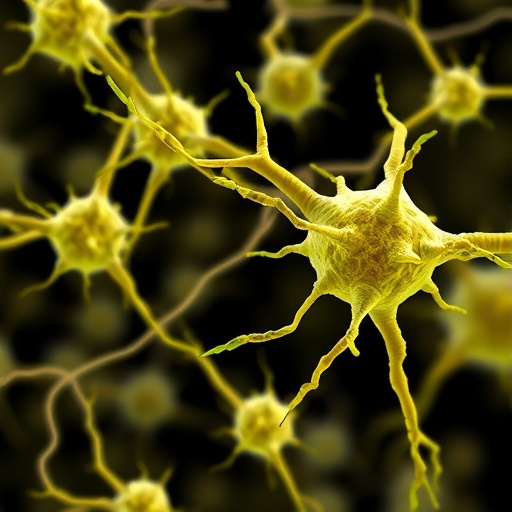In the rapidly evolving landscape of environmental health science, the infiltration of synthetic polymers into biological systems has garnered unprecedented attention. A groundbreaking in vitro investigation recently published in Microplastics & Nanoplastics sheds light on the intricate interactions between polystyrene particles of nano- and micro-scale dimensions and the functional integrity of the small intestinal epithelium, as well as the activity within the enteric nervous system. This pioneering study marks a significant stride forward in our understanding of the subtle yet profound impact that pervasively encountered plastic particles may have on gastrointestinal health and neuronal regulation.
Polystyrene nanoparticles and microparticles, prevalent constituents of environmental pollution, are increasingly recognized as bioavailable entities that can traverse biological barriers. The small intestine, the principal site for nutrient absorption, harbors a highly specialized epithelial layer that maintains selective permeability and orchestrates complex communication with underlying neural networks known as the enteric nervous system (ENS). The in vitro model employed in this study simulates the delicate interfaces within the gut lining, offering a meticulous platform to dissect cellular and neurophysiological perturbations induced by these ubiquitous pollutants.
At the core of this study lies the evaluation of epithelial barrier functions, including tight junction integrity, absorptive capability, and enzymatic activity. Nanoplastic exposure elicited discernible disruptions in tight junction proteins, altering permeability and potentially compromising the mucosal barrier. The resultant paracellular leakage could feasibly facilitate systemic translocation of pathogens and toxins, implicating a hitherto underappreciated vector for gastrointestinal disorders linked to environmental plastic pollution.
.adsslot_V9EWyARzbY{ width:728px !important; height:90px !important; }
@media (max-width:1199px) { .adsslot_V9EWyARzbY{ width:468px !important; height:60px !important; } }
@media (max-width:767px) { .adsslot_V9EWyARzbY{ width:320px !important; height:50px !important; } }
ADVERTISEMENT
Moreover, alterations in epithelial enzyme functionality were observed, signifying impairment in critical digestive processes. Digestive enzymes anchored on the apical side of enterocytes are integral to macronutrient processing; thus, their disruption undermines nutrient bioavailability and intestinal homeostasis. This enzymatic attenuation, juxtaposed with the compromised barrier, outlines a multifaceted assault on gut physiology by nano- and micro-polystyrene particles.
In parallel, the investigation delved into the enteric neuronal activity—a neural circuit capable of autonomous operation and fundamental to gastrointestinal motility, secretion, and reflexes. By employing electrophysiological methods, the researchers documented significant modulation of neuronal excitability and synaptic transmission upon exposure to polystyrene particles. This neuronal dysregulation raises concerns about the potential for microplastic exposure to precipitate enteric neuropathies or exacerbate gut motility disorders, echoing broader neurological implications.
The dual-exposure paradigm, encompassing both nano- and micro-sized particles, reveals nuances in their bio-interactions. Nanoparticles, by virtue of their surface area and propensity for intracellular uptake, elicited more pronounced effects. However, micro-sized particles also imparted significant perturbations, indicating that size alone does not confer safety, and the spectrum of plastic particle sizes warrants comprehensive scrutiny.
Mechanistic insights suggest oxidative stress and inflammatory signaling as underpinning pathways of the observed dysfunctions. Reactive oxygen species generation, alongside upregulation of pro-inflammatory cytokines, creates a hostile microenvironment detrimental to both epithelial cells and enteric neurons. Such a milieu may initiate or potentiate gastrointestinal inflammation, linking environmental exposure to chronic pathological states.
The experimental setup utilized advanced co-culture systems, integrating intestinal epithelial cells with enteric neurons, to recapitulate physiologically relevant cellular crosstalk. This approach enabled unprecedented analysis of intercellular signaling dynamics in response to environmental insults, highlighting the importance of model sophistication in elucidating complex biological phenomena.
Importantly, the findings underscore the latent threat posed by daily human interactions with nanoplastics through diet and environmental contact. The small intestine’s role as a primary barrier and communication hub signifies that disruptions herein may have systemic repercussions, extending beyond localized gut effects to influence overall health status.
Given the escalating presence of plastic debris in the environment, this study contributes critical evidence that urges re-examination of public health policies and waste management strategies. Preventive measures could include tighter regulations on plastic usage, development of biodegradable alternatives, and enhanced public awareness of microplastic exposure routes.
Furthermore, the work opens avenues for targeted therapeutic interventions aiming to mitigate nanoplastic-induced intestinal damage. Antioxidants, barrier enhancers, or modulators of neuronal activity could conceptualize new pharmacological strategies to protect vulnerable populations, especially those with pre-existing gastrointestinal or neurological conditions.
The implications of such research resonate deeply within the scientific and medical communities, illustrating the intertwined fate of environmental stewardship and human health. By unraveling the cellular interplay disrupted by polystyrene particles, the study bridges critical knowledge gaps, positioning plastic pollution not merely as an ecological issue but as a direct health hazard.
As future research builds upon these findings, integrating in vivo models and human clinical studies will be vital to fully delineate the scope and mechanisms of micro- and nanoplastic toxicity. Multidisciplinary collaborations encompassing toxicology, neurogastroenterology, environmental science, and materials engineering promise to accelerate progress toward comprehensive risk assessment and mitigation.
In conclusion, this seminal work crystallizes the urgent need to confront the pervasive challenge of plastic pollution with innovative scientific inquiry and robust policy frameworks. The small intestine’s vulnerability to nano- and micro-polystyrene particles serves as a sentinel warning, advocating for immediate action to curb environmental plastic dissemination and safeguard human health through informed intervention.
Subject of Research: Interaction of nano- and micro-polystyrene particles with small intestinal epithelial functions and enteric neuronal activity in vitro.
Article Title: Effect of nano- and micro-polystyrene particles on small intestinal epithelial functions and enteric neuronal activity in vitro.
Article References: Elfers, K., Benz, P., Burmester, M. et al. Effect of nano- and micro-polystyrene particles on small intestinal epithelial functions and enteric neuronal activity in vitro. Microplast. & Nanopl. 5, 3 (2025). https://doi.org/10.1186/s43591-025-00110-3
Image Credits: AI Generated
Tags: bioavailability of microplasticsenteric nervous system interactionsenvironmental health and synthetic polymersepithelial barrier function in intestinesgastrointestinal health impacts of plasticsgut health and microplasticsin vitro studies on gut cellsmicro polystyrene pollutionnano polystyrene particlesneurophysiological effects of pollutantspolystyrene effects on nutrient absorptiontight junction integrity in intestinal epithelium





